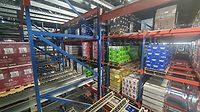Operations
Palletizers, depalletizers serve crucial role in automation’s future in beverages

Shortages within skilled labor and SKU proliferation are contributing to the adoption of palletizing operations, experts note.
Image courtesy of DMW&H
For warehouse automation, the intricate nature in which all operations are tied together highlight the importance of keeping all aspects aligned. When it comes to the incorporation of palletizing and depalletizing systems, experts highlight how these operations serve as the bookends in the automation cycle.
“Palletizers and depalletizers can act as the bookends to a four walls automation system that allows the distribution center to greatly reduce the labor-intensive tasks associated with replenishment and palletizing,” says Kyle Nevenhoven, principal consultant at Dematic, Atlanta. “Depalletizers, whether they are ergonomic manual stations or fully automatic, are a very efficient way of replenishing a case picking and palletizing solution. Likewise, ergonomic manual and automated palletizers can create very dense, and in some cases store friendly, pallets in a very efficient manner.”
Indeed the challenges of the labor market in terms of warehouse operations has prompted companies to realize the benefits of employing automation.
“Labor challenges play a major role in the adoption of automation systems,” Nevenhoven says. “Depalletizers and palletizers as part of a larger automation system can reduce the labor required for two of the more labor-intensive processes, replenishment and picking, that take place in a beverage distribution center. Depalletizers and palletizers as a part of a four walls automation solution are well equipped to handle extensive SKU proliferation and the changing and expanding packaging types that can make picking labor much less efficient than it was in the past.”
Paul Laman, vice president of sales for beverage at DMW&H, Fairfield, N.J., explains how the nature of beverage storage and shipping makes it well aligned for automated systems like palletizers and depalletizers.
“Beverage cases tend to be heavier due to the liquid, can be fragile if in glass bottles, and often have poor packaging; therefore, these factors need to be considered in doing the design,” he says “Yet overall, beverage cases are attractive candidates for automation in palletization, either semi-automated, or fully automated due to their somewhat standard sizes and stackability.”
Laman also highlights how these factors align with turning to palletizers and depalletizers in wake of a shifting labor force.
“Depalletizing and palletizing by hand is heavy and hard work and comes with ergonomic and safety issues,” he says. “Considering the current labor shortages, automation of this less desirable labor component is valuable.”
Mixing into operations
Despite the benefits that palletizing and depalletizing systems can offer, experts note that beverage warehouses have been slower to embrace the technology compared with other industries.
“The beverage distribution industry has adopted depalletizers and palletizers at a slower rate than some other vertical markets, such as grocery distribution,” Dematic’s Nevenhoven says. “Depalletizers have been somewhat uncommon in beverage distribution operations as few automation systems have been implemented for which the picking process is fully automated. Palletizer adoption has been slightly more common, but still slower than some other industries for a variety of factors.”
One of those factors has been the low SKU count compared with other industries. “The exception to this is wine and spirits distribution, however distribution for wine and spirits has generally been via floor loaded trucks,” Nevenhoven says.
But that has been changing in the beverage market.
“SKU proliferation, and the diversity of packaging types, has created an additional level of complexity to palletizing automation in the beverage distribution industry,” Nevenhoven says. “In the past, with a limited SKU range and limited packaging types, layer forming palletizing was possible.
“In the current environment, where orders tend to be more complex, with a greater quantity of SKUs, and a significant variety of packing types, a more robust palletizing machine is required where pallets can be built one or two cases at a time, with a feed of cases in perfect sequence as determined by advanced pallet planning software,” he continues.
What also could push beverage warehouses into the adoption of palletizing equipment are the steps taken with artificial intelligence (AI) to integrate into these systems.
“With the continual progression of software, AI, dimensioners and scanning technologies, the ability to map out the perfect pallet load for sequential loading is becoming a greater reality,” DMW&H’s Laman says.
Dematic’s Nevenhoven also anticipates AI to deliver benefits to warehouses as the technology matures.
“Artificial intelligence has the potential to provide more resiliency to depalletizing and palletizing solutions than what has been possible with past technologies,” Nevenhoven says. “Automated depalletizing of mixed SKU pallets is now able to be facilitated through the use of advanced vision systems and artificial intelligence, with the ability to create a 3D map of a pallet and pick cases individually from that information. For palletizing, artificial intelligence will add resiliency to the palletizing process by way of more intelligently handling exception scenarios, such as out of sequence cases, dimensional variance, and other exception scenarios that currently create a need for manual intervention.”
Looking for a reprint of this article?
From high-res PDFs to custom plaques, order your copy today!







